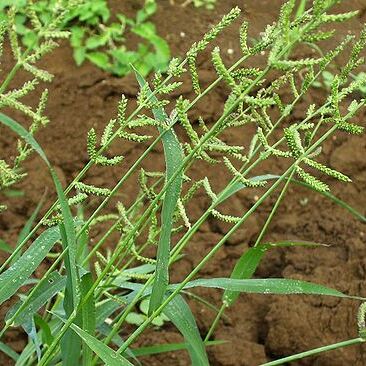Annual. Culms erect or ascending, up to 60 cm or more tall. Leaf sheaths compressed and keeled; leaf blades linear, flat, 3–20 × 0.3–0.7 cm, glabrous, sometimes with transverse purple bands, margins slightly scabrous, apex acute. Inflorescence narrow, 5–10 cm; racemes 1–2 cm, erect or sometimes stiffly diverging, simple, separated or overlapping by up to half their length or more, rachis usually without long, tubercle-based hairs, spikelets tightly congested in 4 neat rows. Spikelets plumply ovate-oblong, 2–3 mm, hirtellous, sharply acute; lower glume ca. 1/2 as long as spikelet; lower lemma staminate or sterile; upper lemma whitish at maturity, elliptic. Fl. and fr. summer and autumn. 2n = 36.
Tufted annual 100-1 000 mm high; hygrophyte; stoloniferous. Leaf blade 50-300 x 2-8 mm; ligule absent. Inflorescence 10-150 mm long, elongated; racemes 10-25 mm long, neatly 4-rowed, without secondary branchlets at base, not or inconspicuously compound. Spikelet 1.5-3.0 x 1.0-1.5 mm, subglobose to ovate-elliptic, pubescent; glumes and lower lemma minutely hairy on surface, nerves with or without long, rigid hairs; lower floret male or sterile; lower lemma awnless; upper lemma 2 to 3 mm long; anther 0.6-1.4 mm long.
Culms weak, freely branched, 1–7 dm; lvs glabrous, the blades 2–6(–9) mm wide; panicle slender, 5–12 cm, with several alternate racemes often 1 cm apart; racemes erect or ascending, blunt, 1–2 cm; spikelets crowded and subsessile in 4 longitudinal rows, 2.5–3 mm, often obovoid, awnless; second glume and sterile lemma uniformly pubescent, the hairs under 0.5 mm; fertile lemma 2.5–2.9 mm, obtuse or acute; 2n=54. Native to the Old World tropics, now a pantrop. weed, extending n. to Va., Mo., Ill., and Calif.
An annual grass. It forms tufts. The stems are slender. It grows up to 60 cm high. Sometimes the plant has a purple tinge. In dry areas the stems can lie along the ground and root at the nodes. The leaves are narrow. They are 0.5-0.7 cm wide. The narrow towards the tip. The flower is yellow. The flower develops in the axils of the leaves. The flower has a rough texture. The flowering heads have several short thick spikes. These have 4 crowded rows of spikelets.
Annual; up to 1 m high; hydrophyte; stoloniferous and tufted. Leaf blades 50-300 x 2-8 mm; ligule absent. Flowers: inflorescence subdigitate; 10-150 mm long; racemes neatly 4-rowed; 10-25 mm long; base with no secondary branchlets spikelets 1.5-3.0 x 1.0-1.5 mm; pubescent; lower floret male or sterile; lower lemma not awned (apex sometimes up to 1 mm long).
Annual, hydrophyte, stoloniferous and tufted, up to 1 m high. Leaf blades 50-300 mm long, 2-8 mm wide; ligule absent. Spikelets 1.5-3.0 mm long, 1.0-1.5 mm wide, pubescent. Inflorescence 10-150 mm long; racemes neatly 4-rowed, 10-25 mm long; lower floret male or sterile; lower lemma not awned (tip sometimes up to 1 mm long).


